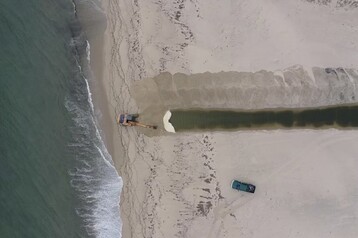Sesachacha Pond Opening Paired With Scientific Research Study On Water Quality
Jason Graziadei •

Sesachacha Pond will be opened to the Atlantic Ocean this morning, and while the practice has been going on for decades, this year will be a little different.
The town's Natural Resources Department is working with the Massachusetts Institute of Technology and the Woods Hole Oceanographic Institute's joint oceanography program to study the impact of breaching Sesachacha Pond on its water quality. Master's degree student researcher Faith Brooks will be taking water samples, abiotic measurements, as well as camera and drone scans of the pond before, during, and after the pond is opened, according to Emma Morgan, the town's water quality specialist.
"This research will provide crucial data to inform future breaches and water quality management in Sesachacha Pond," Morgan said.
The openings of Sesachacha and Hummock Pond are done twice every year to lower nitrogen levels, raise salinity through the exchange of brackish pond waters with the high-quality offshore waters, and allow the entry of marine species, including herring, blue crab, and other species.
According to the Natural Resources Department: “Two of Nantucket’s Great Ponds, which are ponds greater than 10 acres in size, Sesachacha Pond and Hummock Pond are maintained as part of an estuarine system by a spring and a fall breaching of the barrier beach. The ponds have breached naturally and receive ocean overwash, but the scheduled breachings are mechanically opened during designated tide conditions and with appropriate weather conditions. The barrier beach separates the brackish pond from the marine waters of the Atlantic Ocean. Brackish water is a blend of freshwater and of saltwater. Each Pond is breached to lower its nitrogen levels and raise its salinity through the exchange of brackish pond waters with the high-quality offshore waters.

"Studies of Sesachacha Pond in the late 1980's indicated that periodic tidal exchange was required to help stabilize the ecology and these results were reiterated in the recently completed Massachusetts Estuary Plan for each pond. Data has indicated that not conducting the breaching could lead to the salinity levels of the pond dropping, and nutrient levels rising to levels that do not support the species of plants, animals, and invertebrates within the ponds.”
That basis of knowledge will be put to the test by Brooks' new research project.
This year's opening of Sesachacha Pond, which typically takes place in October, is happening much later due to a variety of factors.
"The timing of the openings is always a bit of a toss-up because we are working at the whim of Mother Nature," Morgan said. "This time around, the opening was delayed additionally due to increased permit renewal wait times and contractor availability."
The opening and the MIT/WHOI research will be closely watched by the Quidnet Squam Association and its Sesachacha Pond Task Force. The association has been working closely with the Natural Resources Department and other island conservation groups for the past several years in an effort to improve water quality in Sesachacha Pond, which has suffered from increasingly frequent harmful algal blooms, or HABs.
"This work will also serve as part of the foundation for a separate but related effort by the NRD to revisit the overall management plan for Sesachacha Pond," said Jonah Seiger, the co-chair of the Sesachacha Pond Task Force. "NRD has begun the process of seeking funding in the FY 26 budget for this purpose. The last time the town reviewed the pond management plan for Sesachacha was in 2006. So, this is no ordinary cut – not only because it's happening so late, but also because it - hopefully - portends a major step forward to improving water quality in Sesachacha Pond."